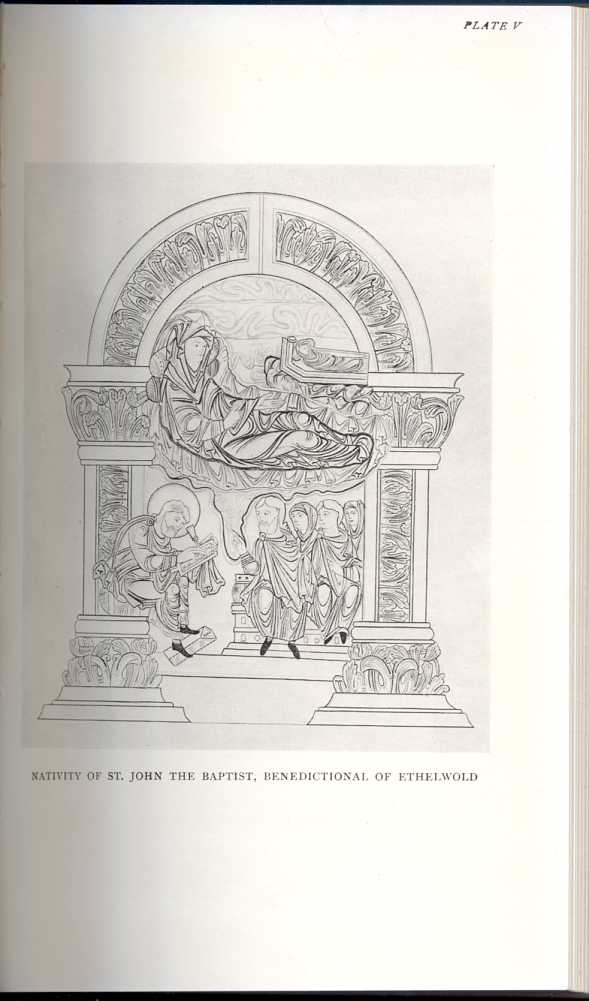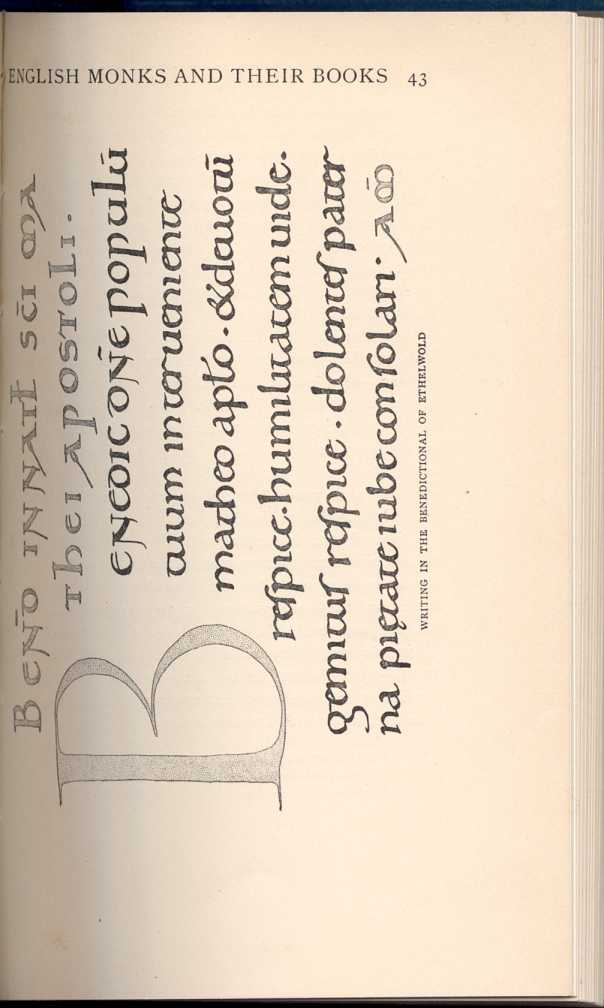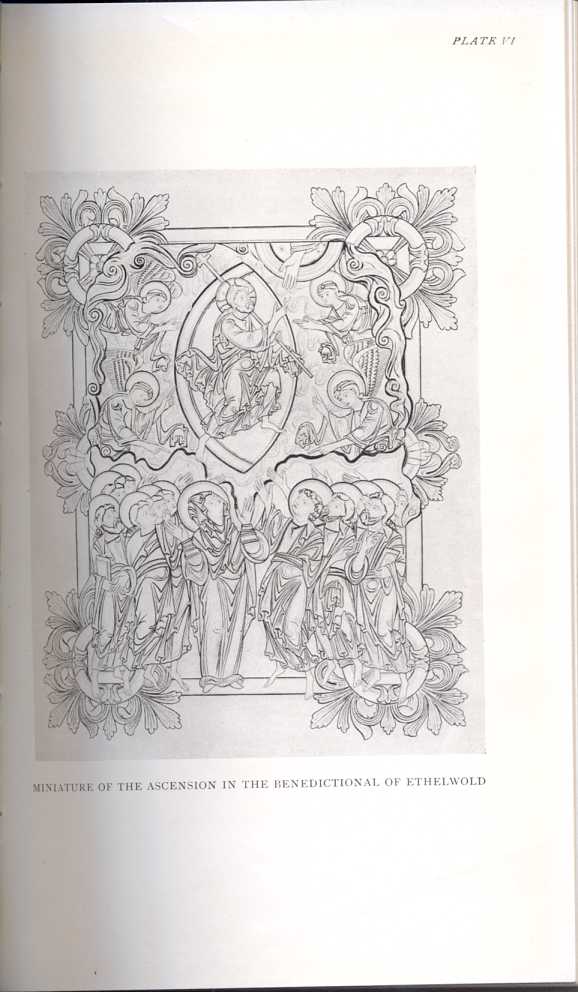| CHAPTER II: THE ENGLISH MONKS AND THEIR BOOKS Old English libraries; the making, collection and use of books during the middle ages | ||
5. § V
Sunlight and shadow follow one another rapidly across England's early history. The migration of York's renowned scholar took place six years before the Viking irruptions began, and about twelve years before a heavy blow was struck at Northumbrian learning by the ravaging and destruction of the monasteries of Lindisfarne, and Wearmouth and Jarrow. After this there was but little peace for England. Kent was often attacked. In 838 the marauders fell upon East Anglia. Between 837 and 845 they made various fierce attacks upon Wessex. In 851 the pillage of Canterbury and London was a severe blow to the English. About fifteen years later, at the hands of the Danes, Melrose, Tynemouth, Whitby, and Lastingham shared Wearmouth's fate. Of York and its library we hear no more. Peterborough and its large collection of sacred books perished at the hands of the same raiders as those who burnt Crowland (870). So bad grew affairs that Alfred the Great, writing to Bishop Werfrith, bewailed the small number of people south of the Humber who understood the English of their service, or could translate from Latin into English. Even beyond the Humber there were not many; not one could he remember south of the Thames when he began to reign. And he bethought himself of the wise men, both church and lay folk, formerly living in England, and how zealous they were in teaching and learning, and how men came from abroad in search of wisdom and instruction. Apparently some decline from this standard had been noticeable before ruin completely overtook the monasteries. He remembered how, before the land had been ravaged and burnt, "its churches stood filled with treasures and books,
This letter, written in 890, marks the revival of interest in letters under Alfred. In adding to his own knowledge, and in promoting education among his people, he was assiduous and determined. During the leisure of one period of eight months, Asser seems to have read to him all the congenial books at hand, Alfred's custom being to read aloud or to listen to others reading. Asser was a Welsh bishop, brought to Wessex to help the king in his work. For the same purpose Archbishop Plegmund[2.23] and Bishop Werfrith were brought from Mercia. Other scholars came from abroad. One named Grimbald, a monk from St. Bertin, came to take charge of the abbey of Hyde, Winchester, which Alfred had planned. John, of Old-Saxony, a learned monk of the flourishing Westphalian Abbey of
That Alfred, amid the cares of a troublesome kingship, could find time to devote to this work, and realised the importance of vernacular literature, is one of the chief signs of his greatness. What he did had a lasting influence upon our literature. He tapped the wellspring of English prose. Mainly owing to his initiative, from his day till the Conquest all the literature of importance was in the vernacular, and the impulse so given to the language as a literary vehicle was strong enough to preserve it from extinction during the Norman domination, when it was superseded as the court and official language. But, so far as the making and circulation of books is concerned, the "revival" under Alfred did not prosper. The necessary machinery was almost entirely wanting. The monastic schools, the great—the only—means of disseminating the learning of the time, were few in number and not very influential. For Athelney, a small monastery, Alfred had difficulty in finding monks at all: he had to get them from abroad; while the rule in this house does not seem to have been wholly satisfactory. At the time of his death (c. 901) monachism was in a bad way. Fifty years later its plight would seem to have been worse. Only two houses, Abingdon and Glastonbury, could be really called monastic. "In the middle of the tenth century the Rule of St.
The leaders were Dunstan and Ethelwold. In youth the former was renowned for his eagerness in studying, and for the wealth and knowledge he acquired. He was a "lover of ballads and music," "a hard student, an indefatigable worker, busy at books"; spending his leisure in reading sacred authors, and in correcting manuscripts, sometimes at daybreak. He was also very skilful at working in metal
Some beautiful examples of work of this period have been
preserved. "Winchester" work is a familiar and expressive term in
illumination, and nobody will ask why this is so if they have seen a
manuscript executed there towards the end of the tenth century. The
Benedictional and Missal of Archbishop Robert, which is certainly
English, and most likely an example of New Minster work, is illuminated
with miniatures, foliated and architectural borders, and capitals and
letters of gold, in virile workmanship. A still finer example—the
finest example of Old Minster craft—is the Benedictional of Ethelwold,
now in the Duke of Devonshire's library. The versified dedication,
inscribed in letters of gold, tells us, in substance—"The Great
Æthelwold . . . illustrious, venerable and mild . . . commanded a
certain monk subject to him to write the present book: he ordered also
to be made in it many arches elegantly decorated and filled up with
various ornamented pictures expressed in divers beautiful colours, and
gold."[2.30] Godeman, abbot of Thorney, was
the scribe, but the illuminator is unknown. Each full page has nineteen
lines of writing, with letters nearly a quarter of an inch long.
Alternate lines in gold, red, and black occur once or twice in the same
page. There are thirty miniatures and thirteen fully illuminated pages,
some of these having framed borders, foliated, others columns and
arches. The figures are remarkably well drawn, the drapery being
especially good. The whole is in a fine state of preservation,
especially the gold ornaments; the gold used was leaf upon size,
afterwards well burnished. Of the rival craftsmanship at New Minster we
have a splendid example in the Golden Book of Edgar, so called
 [Description: NATIVITY OF ST. JOHN THE BAPTIST,
BENEDICTIONAL OF ETHLWOLD]
[Description: NATIVITY OF ST. JOHN THE BAPTIST,
BENEDICTIONAL OF ETHLWOLD]
 [Description: WRITTING IN THE BENEDICTIONAL OF
ETHLWOLD]
[Description: WRITTING IN THE BENEDICTIONAL OF
ETHLWOLD]One of Ethelwold's pupils was Ælfric, who became Archbishop of Canterbury in 995. He was responsible for the canon requiring every priest, before ordination, to have the Psalter, the Epistles, the Gospels, a Missal, the Book of Hymns, the Manual, the Calendar, the Passional, the Penitential, and the Lectionary. On his death he bequeathed all his books to St. Albans.[2.32]
Another pupil of the same name is still more famous. This scholar's grammar, with its translated passages, his glossary—the oldest Latin-English dictionary—and his conversation-manual of questions and answers, with interlinear translations, suggest that he must have done much to make the study of Latin easier and more congenial; while his homilies display his art in making knowledge popular, and prove him to be the greatest master of English prose before the Conquest.
Several other interesting and suggestive facts belonging to this period have been preserved for us. Abbot Ælfward, for example, gave to his abbey of Evesham many sacred books and books on grammar (c. 1035): here, at any rate, progress was real. [2.33] At a manor of the abbey of Bury St. Edmunds were thirty volumes, exclusive of church books (1044-65). [2.34] Bishop Leofric also obtained over sixty books for Exeter Cathedral about sixteen years before the Conquest, a collection to which we must refer later.
 [Description: MINIATURE OF THE ASCENSION IN THE
BENEDICTIONAL OF ETHELWOLD]
[Description: MINIATURE OF THE ASCENSION IN THE
BENEDICTIONAL OF ETHELWOLD]
| CHAPTER II: THE ENGLISH MONKS AND THEIR BOOKS Old English libraries; the making, collection and use of books during the middle ages | ||